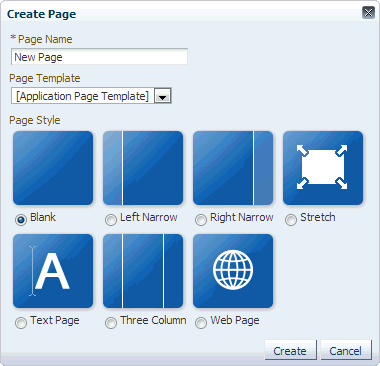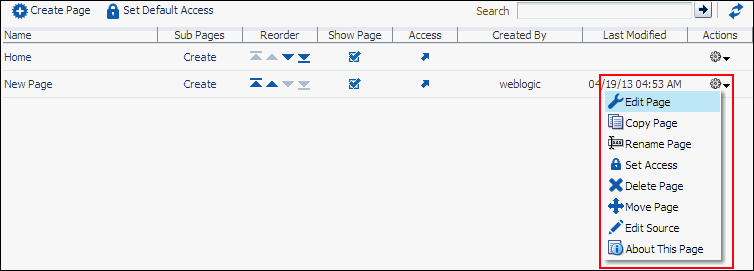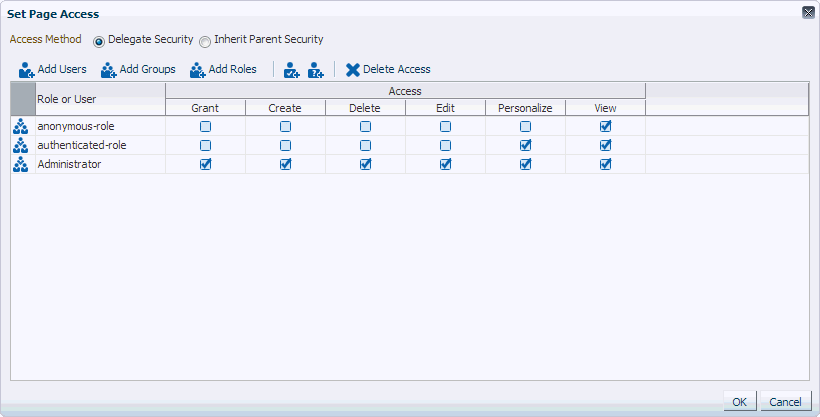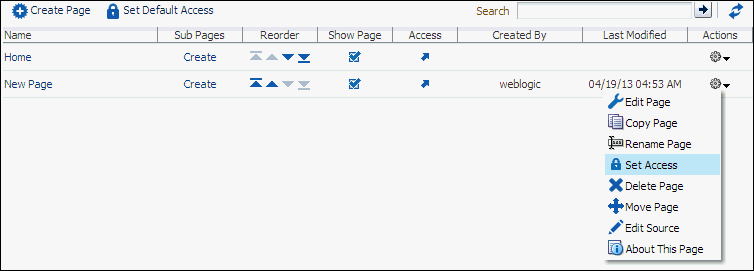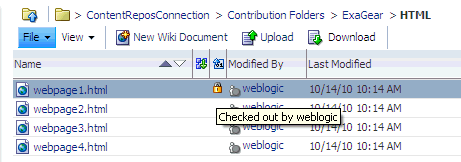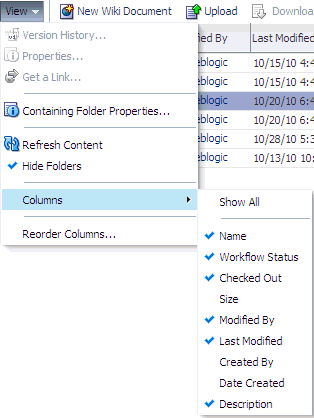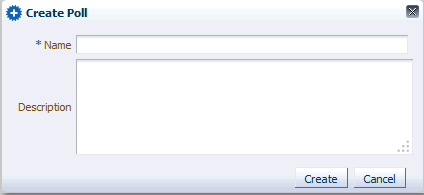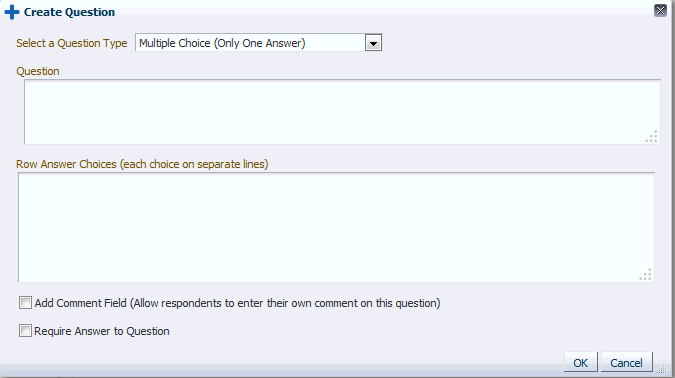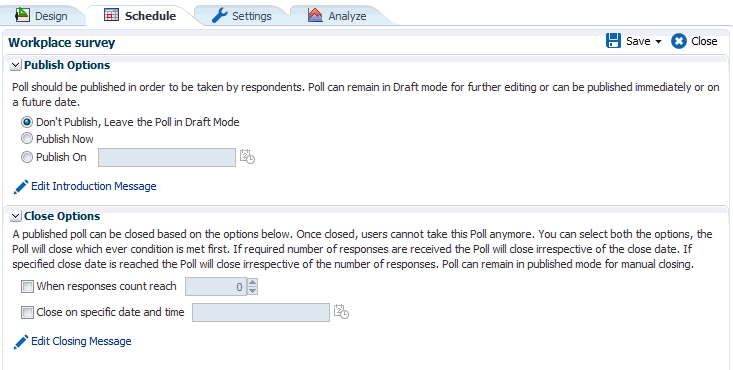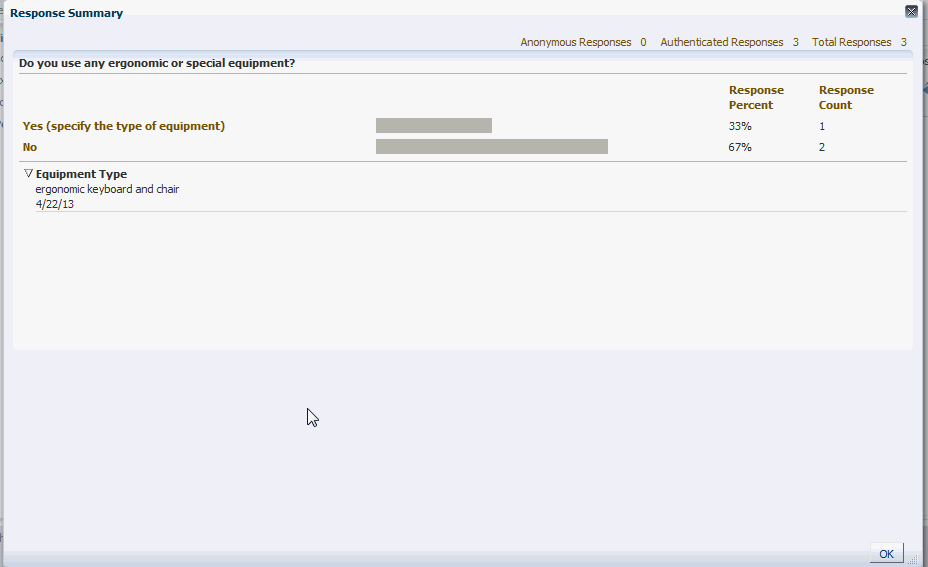43 Administering Portal Framework Applications Using the Administration Console
This chapter provides information about the runtime administration console that is available for Portal Framework applications. Portal Framework applications are portal applications built using the WebCenter Portal Framework application template in Oracle JDeveloper
This chapter includes the following topics:
-
Section 43.1, "Introduction to the Administration Console for Portal Framework Applications"
-
Section 43.2, "Accessing the Administration Console for Portal Framework Applications"
-
Section 43.3, "Configuring Defaults for Portal Framework Applications"
-
Section 43.4, "Managing Members and Roles for Portal Framework Applications"
-
Section 43.5, "Managing Assets for a Portal Framework Application"
-
Section 43.7, "Propagating Portal Framework Application Changes From Staging to Production"
Permissions:
To perform the tasks in this chapter, you must be granted the Administrator role through the Portal Framework application's Administration Console. For details, see Section 43.4.2, "Understanding Application Roles and Permissions"
See also, Section 1.8, "Understanding Administrative Operations, Roles, and Tools."
43.1 Introduction to the Administration Console for Portal Framework Applications
By default, Portal Framework applications offer several administration pages (Figure 43-1) that enable authenticated administrators to perform common administrative duties, including:
-
Setting application-level preferences
-
Managing users and granting application roles
-
Managing and configuring application assets
-
Managing content
-
Managing and configuring portlet producers
-
Managing and configuring external applications
-
Creating and managing polls
-
Propagating application updates
Figure 43-1 WebCenter Portal Administration Console

Description of "Figure 43-1 WebCenter Portal Administration Console"
43.2 Accessing the Administration Console for Portal Framework Applications
To access the administration console for a Portal Framework application:
-
Log in to your application as an administrator.
Initially, the WebCenter Portal Administration Console is only available to the system administrator. For information on how to grant the
Administratorrole to others, see Section 43.4.3.3, "Giving a User Administrative Privileges." -
Do one of the following:
-
Click the Administration link (Figure 43-2).
Figure 43-2 WebCenter Portal Administration Console - Administration Link

Description of "Figure 43-2 WebCenter Portal Administration Console - Administration Link"
-
Access the WebCenter Portal Administration Console using the direct URL:
The default direct URL is:
http://www.server:port/context_root/admin
For example:
http://mycompany.com:8888/myapp/adminApplication developers can, however, customize the direct URL using the
web.xmlentry:<servlet-mapping> <servlet-name>PortalAdminServlet</servlet-name> <url-pattern>/admin</url-pattern> </servlet-mapping>
The WebCenter Portal Administration Console displays (see Figure 43-1).
-
43.3 Configuring Defaults for Portal Framework Applications
On deployment, Portal Framework applications are pre-configured with various default settings which administrators can customize to suit their audience through the WebCenter Portal Administration Console. From the Configuration tab (Figure 43-3), you can specify a default page template, skin, resource catalog, and navigation model.
Figure 43-3 WebCenter Portal Administration Console - Configuration Tab

Description of "Figure 43-3 WebCenter Portal Administration Console - Configuration Tab"
This section includes the following topics:
43.3.1 Choosing a Default Page Template
In a Portal Framework application, page templates define how individual pages and groups of pages display on a user's screen. Every page displays within a page template. For more information, see the "Developing Page Templates" chapter in Oracle Fusion Middleware Developing Portals with Oracle WebCenter Portal and Oracle JDeveloper.
Administrators can define the default page template that is used to display pages.
To select a default page template for the application:
-
Navigate to the Configuration administration tab.
See Section 43.2, "Accessing the Administration Console for Portal Framework Applications."
-
Choose a Default Page Template from the list provided.
The template you select is applied to existing pages and any new pages that are created.
Note:
If users create pages and hard-code links to page templates, the Default Page Template has no effect.
-
Click Apply.
43.3.2 Choosing Default Resource Catalogs
In a Portal Framework application, the resource catalog specifies a collection of elements, such as layout components, task flows, portlets, documents, and others, that authorized users can add to the application at runtime. For more information, see the "Developing Resource Catalogs" chapter in Oracle Fusion Middleware Developing Portals with Oracle WebCenter Portal and Oracle JDeveloper.
To select a default resource catalog for the application:
-
Navigate to the Configuration administration tab.
See Section 43.2, "Accessing the Administration Console for Portal Framework Applications."
-
Choose a Default Resource Catalog from the list provided.
The catalog you select is offered to users when they add content to pages, page templates, and so on.
-
Click Apply.
43.3.3 Choosing a Default Navigation
Navigations enable users to easily get around your Portal Framework application and quickly access the information they need. For more information, see the "Developing a Navigation Model" chapter in Oracle Fusion Middleware Developing Portals with Oracle WebCenter Portal and Oracle JDeveloper.
Administrators can define the navigation used wherever there is a EL reference to ${navigationContext.defaultNavigation}. This enables administrators to specify a default navigation model once and have it change throughout the system.
To choose a default navigation for the application:
-
Navigate to the Configuration administration tab.
See Section 43.2, "Accessing the Administration Console for Portal Framework Applications."
-
Choose a Default Navigation from the list provided.
The navigation you select is applied wherever there is a EL reference to
${navigationContext.defaultNavigation}.Note:
If users hard-code navigation model references (for example, in a parameter to a task flow), the Default Navigation has no effect.
-
Click Apply.
43.3.4 Choosing a Default Skin
System administrators can customize the default appearance of a Portal Framework application by changing its skin. A skin changes the way the user interface appears, but does not change the application's behavior.
To choose a default skin:
-
Navigate to the Configuration administration tab.
See Section 43.2, "Accessing the Administration Console for Portal Framework Applications."
-
Choose a Default Skin from the list provided.
The skin you select is applied to all the pages in your application.
Note:
The Default Skin has no effect on administration pages because the WebCenter Portal Administration Console uses an internal skin that does not change.
-
Click Apply.
43.3.5 Choosing the Default Base Resource URL
Developers can use EL expressions to dynamically generate the target URL for static resources. One way of doing this is to define a base URL preference to redirect resources to a desired server. With this option, EL expressions take a format that is illustrated by the following sample:
<af:image source="#{preferenceBean.baseResourceURL}/images/globe.png"/>
Administrators can configure the base URL at runtime in the application's administration console.
To choose the default base resource URL:
-
Navigate to the Configuration administration tab.
See Section 43.2, "Accessing the Administration Console for Portal Framework Applications."
-
In the Base Resource URL field, enter the details for the server to use for static resources, using the following format:
protocol://serverName:serverPortcontextPath
For example:
http://myserver.com:7101/myFolder
Tip:
You can also use an EL expression that resolves to a valid server. For example, the default setting is:
#{request.scheme}://#{request.serverName}:#{request.serverPort}#{request.contextPath}
43.4 Managing Members and Roles for Portal Framework Applications
Users who are granted the Administrator role, can manage application members and roles through the WebCenter Portal Administration Console. From the Security tab (Figure 43-4), you can add members, define roles, grant and revoke permissions and roles, as well as remove members.
Figure 43-4 WebCenter Portal Administration Console - Security Tab

Description of "Figure 43-4 WebCenter Portal Administration Console - Security Tab"
This section contains the following topics:
-
Section 43.4.2, "Understanding Application Roles and Permissions"
-
Section 43.4.4, "Managing Application Roles and Permissions"
Note:
The Security tab displays the Role Manager task flow, which can be added independently to any Portal Framework application. For more information, see the "Using the Role Manager Task Flow" section in Oracle Fusion Middleware Developing Portals with Oracle WebCenter Portal and Oracle JDeveloper.
43.4.1 Understanding Users
Portal Framework application users each require a login account—provisioned directly from an existing identity store. Initially, only the system administrator (weblogic by default) can login and this default user has full administrative privileges through the Administrator role (see Table 43-1).
It is the system administrator's job to make individual users and user groups, who exist in the identity store, members of the application and to assign each member an appropriate application role. Default and custom application roles are described in Section 43.4.2.1, "Understanding Application Roles."
Alternatively, the system administrator may also choose to assign the application Administrator role to one or more other users and delegate this responsibility to others.
43.4.2 Understanding Application Roles and Permissions
Application roles control the level of access a user has to assets and services in a Portal Framework application. This section describes application roles and permissions and includes the following topics:
43.4.2.1 Understanding Application Roles
Application role assignment is the responsibility of the system administrator. Administrators can assign members a default application role or create additional, custom roles specific to their application. For more detail, see:
Application roles and permissions defined within a Portal Framework application are stored in its policy store and, consequently, only apply to the application and do not imply any other permissions within the WebCenter Portal domain or other domains. Enterprise roles are different; enterprise roles are stored within the application's identity store and do not imply any permissions within the application.
43.4.2.1.1 Default Application Roles
Portal Framework applications provide several default application roles that cannot be deleted (Table 43-2).
Table 43-2 Default Roles for a Portal Framework Application
| Application Role | Description |
|---|---|
|
|
Users with the Administrators can also manage users and roles for the application, and delegate or revoke privileges to/from other users. Initially, the |
|
|
Users with this role can manage (create, update, and delete) portlet producers and external applications through corresponding task flows. Initially, only users with the |
|
|
Users with this role can view portlet producers and external applications through corresponding task flows.. Initially, any user who is logged in (that is, has No direct permissions are granted to the |
|
|
Authenticated users are granted the |
|
|
Anyone who can access the application but is not logged in, is granted the |
43.4.2.1.2 Custom Application Roles
Custom application roles (sometimes known as user-defined roles) are specific to your Portal Framework application. When setting up the application, it is the administrator's job to identify which application roles are required, select suitable role names, and define the responsibilities of each role.
For example, an education environment might require roles such as Teacher, Student, and Guest. While roles such as Finance, Sales, Human Resources, and Support would be more appropriate for a corporate environment.
To learn how to set up applications roles for users, see Section 43.4.4.1, "Defining Application Roles."
43.4.2.2 Understanding Application Permissions
Every application role has specific, defined capabilities known as permissions. These permissions allow individuals to perform specific actions within the application. Note that no permission, inherits privileges from other permissions.
This section contains the following topics:
43.4.2.2.1 Application Permissions
Application permissions are categorized and listed in Table 43-3:
No permission, except for Manage, inherits privileges from other permissions.
Table 43-3 Application Permissions in Portal Framework Applications
| Category | Application Permissions |
|---|---|
|
Application |
Manage - Enables access to all Administration Console pages: Assets, Services, Security, Configuration, Propagation. Through these pages, users can manage application security (users/roles), configure application-wide properties and services, manage application assets, create and manage pages, and propagate application changes. Configure - Enables users to view and perform operations on the Configuration tab. Propagate - Enables users to view and perform operations on the Propagation tab. |
|
Task Flow Styles |
Create, Edit, and Delete - Create, edit and delete task flow styles for the application using the WebCenter Portal Administration Console (Assets tab). Create - Create task flow styles for the application. Edit - Edit task flow styles. See Chapter 43, "Managing Assets for a Portal Framework Application." |
|
Content Presenter Templates |
Create, Edit, and Delete - Upload, edit and delete content presenter templates for the application using the WebCenter Portal Administration Console (Assets tab). Create - Upload content presenter templates for the application. Edit - Edit application-level content presenter templates. See Chapter 43, "Managing Assets for a Portal Framework Application." |
|
Skins |
Create, Edit, and Delete - Create, edit and delete skins using the WebCenter Portal Administration Console (Assets tab). Create - Create skins for the application. Edit - Edit skins. See Chapter 43, "Managing Assets for a Portal Framework Application." |
|
Task Flows |
Create, Edit, and Delete - Create, edit and delete task flows based on a task flow style using the WebCenter Portal Administration Console (Assets tab). Create - Create task flows for the application. Edit - Edit task flows. See Chapter 43, "Managing Assets for a Portal Framework Application." |
|
Resource Catalogs |
Create, Edit, and Delete - Create, edit and delete resource catalogs for the application using the WebCenter Portal Administration Console (Assets tab). Create - Create resource catalogs for the application. Edit - Edit resource catalogs. See Chapter 43, "Managing Assets for a Portal Framework Application." |
|
Page Styles |
Create, Edit, and Delete - Create, edit and delete page styles using the WebCenter Portal Administration Console (Assets tab). Create - Create page styles for the application. Edit - Edit page styles. See Chapter 43, "Managing Assets for a Portal Framework Application." |
|
Data Controls |
Create, Edit, and Delete - Create, edit and delete data controls for the application using the WebCenter Portal Administration Console (Assets tab). Create - Create data controls for the application. Edit - Edit data controls. See Chapter 43, "Managing Assets for a Portal Framework Application." |
|
Navigations |
Create, Edit, and Delete - Create, edit and delete navigations for the application using the WebCenter Portal Administration Console (Assets tab). Create - Create navigations for the application. Edit - Edit navigations. See Chapter 43, "Managing Assets for a Portal Framework Application." |
|
Page Templates |
Create, Edit, and Delete - Create, edit and delete page templates using the WebCenter Portal Administration Console (Assets tab). Create - Create page templates for the application. Edit - Edit page templates. See Chapter 43, "Managing Assets for a Portal Framework Application." |
|
Pages |
Grant Page Access - Manage page security. Edit Pages - Add or edit page content, rearrange content, and set page parameters and properties. Customize Pages - Customize pages for everyone. Personalize Pages - Personalize your view of pages by adding, editing, or removing content. View - View pages. |
|
Links |
Create, and Delete - Create and delete links between objects, and manage link permissions. Delete - Delete a link between two objects. Create - Create links between objects. |
|
Lists |
Create, Edit, and Delete - Create, edit, and delete lists and list data. Create Lists - Create lists. Edit Lists - Edit list column definitions. Delete Lists - Delete any list. Edit List Data - Add, edit, and delete list data. View Lists - View lists and list data. |
|
People Connections |
Manage People Connections -Manage application-wide settings for People Connection services. Update People Connections Data -Edit content associated with People Connection services. Connect with People -Share content associated with People Connection services with others. |
43.4.2.2.2 Discussion Server Role Mapping
Some services that need access to "remote" (back-end) resources also require role-mapping based authorization. That is, the roles that allow users to work with the discussions in a Portal Framework application, must be mapped to corresponding roles on the back-end discussions server.
A Portal Framework application uses application roles to manage user permissions within the application. On the discussions server, a different set of roles and permissions apply.
A Portal Framework application user who is assigned the Discussions-Create Edit Delete permission is automatically added as a discussions server user and assigned the Administrator role (on the discussions server) with Category Admin permissions. In Portal Framework applications, the Administrator role is granted the Discussions-Create Edit Delete permission by default as shown in Table 43-4.
Table 43-4 Discussions Server Roles and Permissions
| Discussion Server Role | Discussion Server Permissions | Portal Framework Application Equivalent Application Permission |
|---|---|---|
|
Administrator |
Category Admin |
Create, read, update and delete sub categories, forums and topics inside the category for which permissions are granted. |
43.4.2.2.3 Understanding Enterprise Group Role Mapping
You can assign individual users or multiple users in the same enterprise group to Portal Framework application roles. Subsequent enterprise group updates in the back-end identity store are then automatically reflected in the Portal Framework application. Initially, when you assign an enterprise group to a Portal Framework application role, everyone in the enterprise group is granted that role. If someone moves out of the group, the role is revoked. If someone joins the group, they are granted the role.
For a Portal Framework application to properly maintain enterprise group-to-role mappings, back-end servers, such as the discussions server and content server, must support enterprise groups too. WebCenter Portal's discussions server and WebCenter Content's Content Server versions provided with this release both support enterprise groups but previous versions may not.
Note:
Adding users to groups that have been assigned a role is not dynamic. That is, the user may not immediately have access to assets based on the role. To work around this, you can either clear the cache using the refreshGroupSpaceCache WLST command as shown in the example below:
refreshGroupSpaceCache(appName='webcenter', spaceNames='', syncMode=true, updateType='all', cleanCache=false)
or just wait for the cache to refresh.
43.4.3 Managing Users
Administrators must ensure that all application users have appropriate permissions. To get permissions, users must be granted membership to the application through an appropriate application role.
This section tells you how to add members and assign roles. It contains the following topics:
43.4.3.1 Adding Members to Application Roles
You can grant membership to individual users or multiple users in the same enterprise group through the Security tab. Any user or group defined in the identity store is eligible for membership. See Section 31.3, "Adding Users to the Embedded LDAP Identity Store."
Updates in your back-end identity store, such as new users or someone leaving an enterprise group, are automatically reflected in the Portal Framework application. Initially, when you assign an enterprise group to an application role, everyone in the group is granted that role. If someone moves out of the group, the role is revoked. If someone joins the group, they are granted the role.
Note:
For a Portal Framework application to properly maintain enterprise group-to-role mappings, back-end servers, such as the discussions server and content server, must support enterprise groups too. WebCenter Portal's discussion server and Oracle WebCenter Content provided with WebCenter Portal 11.1.1.2.0 and later support enterprise groups but earlier versions may not.
To grant user membership through an appropriate application role:
-
Navigate to the Security administration tab.
See Section 43.2, "Accessing the Administration Console for Portal Framework Applications."
-
In the Role Name pane, select the role to assign to the user.
Notice that the current list of members assigned to the role you select are listed on the right (in the Members pane).
Only choose Administrator to assign full, administrative privileges for your application. If the role you want is not listed, create a new role that meets your requirements (see Section 43.4.4.1, "Defining Application Roles").
-
Click Add Users, Add Groups, or Add Roles (Figure 43-5):
Add Users - click to grant membership to individual users
Add Groups - click to grant membership to everyone in a user group
Add Roles - click to grant membership to everyone assigned to a particular application role
Figure 43-5 WebCenter Portal Administration Console - Add Members

Description of "Figure 43-5 WebCenter Portal Administration Console - Add Members"
-
If you know the exact name of the user, group, or application role, enter the name in the search box (Add People, Add Group or Add Role) and click the arrow icon. If you are not sure of the name you can search your identity store using part of the name as shown below (see Figure 43-6).
Figure 43-6 Add Users Pane - People Search
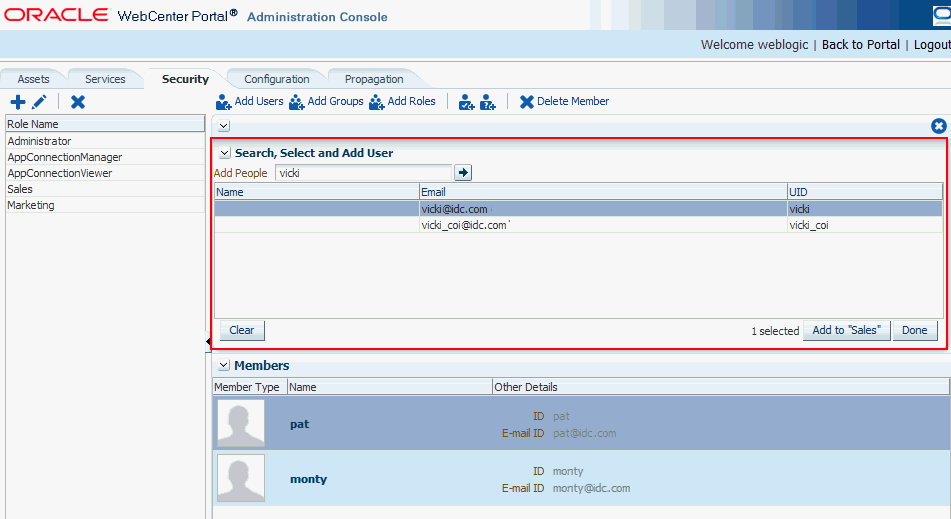
Description of "Figure 43-6 Add Users Pane - People Search"
-
Select the user, group, or role to whom you want to grant the selected role, and click Add to. Use the Ctrl key to select multiple names.
Note:
If the user, group, or role already has the role, directly or indirectly, the role is not granted; cyclic role assignments are not allowed.
The new members display in the Members pane.
-
Click Done when finished.
43.4.3.2 Assigning a User to a Different Role
From time to time, a user's role in a Portal Framework application may change. For example, a user may move out of sales into the finance department and in this instance, the user's role assignment may change from Sales to Finance. To change a user's role, first revoke membership for the user's previous role, then add the user to the new role. For more information see Section 43.4.3.4, "Revoking Application Roles" and Section 43.4.3.1, "Adding Members to Application Roles."
Note:
You cannot modify your own role or the system administrator's role. See Section 43.4.2.1, "Understanding Application Roles."
43.4.3.3 Giving a User Administrative Privileges
It's easy to give a user full, administrative privileges for your Portal Framework application through the Administrator role. Administrators have the highest privilege level and can view and modify anything in the application so take care when assigning the Administrator role.
Most administrative tasks, such as managing users and roles, are exclusive to the Administrator role. See Section 43.4.2.1.1, "Default Application Roles."
43.4.3.4 Revoking Application Roles
It's easy to revoke application role assignments that no longer apply. Note, however, that revoking all of a user's application roles does not remove that user from the identity store.
Note:
You cannot revoke your own role assignments or the system administrator's role. See Section 43.4.2, "Understanding Application Roles and Permissions."
To revoke application roles:
-
Navigate to the Security administration tab.
See Section 43.2, "Accessing the Administration Console for Portal Framework Applications."
-
Select the role from the Role Name pane.
-
Select a user, group, or application role from the Members list.
-
Click Delete Member.
-
When prompted, click Delete to revoke the role for the user.
43.4.3.5 Adding or Removing Users
Administrators cannot add new user data directly to the Portal Framework application's identity store or remove user credentials. Identity store management is the responsibility of the systems administrator and takes place through the WLS Administration Console or directly into embedded LDAP identity stores using LDAP commands. See Section 31.3, "Adding Users to the Embedded LDAP Identity Store."
43.4.4 Managing Application Roles and Permissions
Portal Framework applications use application roles to manage permissions for users within the application. This section tells you how to manage application roles, and their permissions from the Security administration page (Figure 43-7).
Figure 43-7 WebCenter Portal Administration Console - Security Tab

Description of "Figure 43-7 WebCenter Portal Administration Console - Security Tab"
Portal Framework applications provide several default application roles. You cannot delete default application roles but you can modify the default permission assignments for each role. For more information, see Section 43.4.2, "Understanding Application Roles and Permissions."
This section contains the following topics:
-
Section 43.4.4.3, "Granting or Removing Roles for Unauthenticated Users"
-
Section 43.4.4.4, "Granting Roles to All Authenticated Users"
43.4.4.1 Defining Application Roles
Use roles to characterize groups of application users and determine what they can see and do within their Portal Framework application.
When defining application roles, use self-descriptive role names and try to keep the role policy as simple as possible. Choose as few roles as you can, while maintaining an effective policy.
Take care to assign appropriate access rights when assigning permissions for new roles. Do not allow users to perform more actions than are necessary for the role, but at the same time, try not to inadvertently restrict them from activities they must perform. In some cases, users might fall into multiple roles.
To define a new application role:
-
Navigate to the Security administration tab.
See Section 43.2, "Accessing the Administration Console for Portal Framework Applications".
-
Click the Add icon (plus) above the Role Name pane.
The Create Role dialog displays (Figure 43-8).
Figure 43-8 WebCenter Portal Administration Console - Create Role Dialog
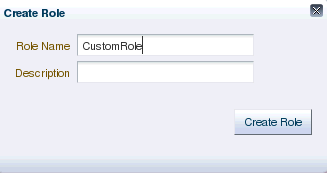
Description of "Figure 43-8 WebCenter Portal Administration Console - Create Role Dialog"
-
Enter a name and description for the new role, and click Create Role.
Ensure the role name is self-descriptive. Make it as obvious as possible which users should belong to which roles. Role names can contain alphanumeric characters, blank spaces, @, and underscores.
The new role is listed in the Roles pane (Figure 43-9).
Figure 43-9 WebCenter Portal Administration Console - Roles Pane
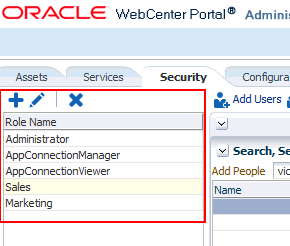
Description of "Figure 43-9 WebCenter Portal Administration Console - Roles Pane"
-
Continue by defining the user permissions for the role as described in Section 43.4.4.2, "Modifying Application Role Permissions."
43.4.4.2 Modifying Application Role Permissions
Permissions should always be set after creating a new role, but administrators can modify the permissions associated with an application role at any time.
Application role permissions allow individuals to perform specific actions within their application. Application permissions are described in Section 43.4.2, "Understanding Application Roles and Permissions."
To change the permissions assigned to a role:
-
Navigate to the Security administration tab.
See Section 43.2, "Accessing the Administration Console for Portal Framework Applications."
-
Select the role for which to view or modify permissions, and click the Edit icon (pencil).
The Edit Role dialog displays with the current permissions for the role (Figure 43-10).
Figure 43-10 WebCenter Portal Administration Console - Edit Role Dialog
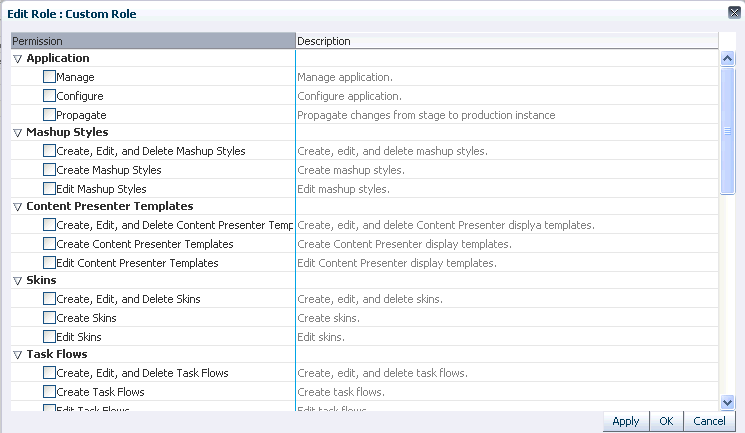
Description of "Figure 43-10 WebCenter Portal Administration Console - Edit Role Dialog"
-
Select or clear permissions check boxes to enable or disable permissions for the role.
-
Click Apply to save or OK to save and exit.
The new permissions are effective immediately.
43.4.4.3 Granting or Removing Roles for Unauthenticated Users
Anyone who is not logged in to a Portal Framework application assumes the anonymous-role. Initially, users with the anonymous-role have no privileges and only see public application pages, such as the login or landing page, and also content that individual users choose to make public.
Caution:
Take care when granting privileges to the anonymous-role. Avoid granting administrative privileges, or any permission that might be considered unnecessary. For security reasons, Oracle recommends that you limit what anonymous users can see and do in your application. If you have no public or anonymous access to your application, any grants that are currently given to anonymous-role should be removed or moved to authenticated-role.
To grant application roles to the public:
-
Navigate to the Security administration tab.
See Section 43.2, "Accessing the Administration Console for Portal Framework Applications."
-
If you have not done so already, define a role that grants permissions suitable for unauthenticated users.
-
Select the role that defines privileges suitable for unauthenticated users.
-
Click Add Anonymous Role for Public Access (Figure 43-11). (If the
anonymous-rolehas already been added and you want to remove it, click Delete.)Figure 43-11 WebCenter Portal Administration Console - Add Public Access

Description of "Figure 43-11 WebCenter Portal Administration Console - Add Public Access"
The anonymous-role is added to the members list (Figure 43-12).
Figure 43-12 WebCenter Portal Administration Console - Add Public Access

Description of "Figure 43-12 WebCenter Portal Administration Console - Add Public Access"
43.4.4.4 Granting Roles to All Authenticated Users
Anyone who is logged in to a Portal Framework application assumes the authenticated-role.
Other important notes:
-
Since all authenticated users are also under
anonymous-role, all grants given toanonymous-roleautomatically accrue to authenticated users. -
Custom application roles all inherit permissions from the
authenticated-role.
43.4.4.5 Deleting Application Roles
When an application role is no longer required you should remove it from your application. This helps maintain a valid role list, and prevents inappropriate role assignment. You cannot, however, delete a role that is granted to you, directly or indirectly.
Application roles are deleted even when users are still assigned to them.
Note:
Default roles cannot be deleted: Administrator, AppConnectionManager, AppConnectionViewer, authenticated-role, anonymous-role. See Section 43.4.2.1.1, "Default Application Roles."
As you cannot delete default roles, application users can log in through the authenticated-role, even when all other application roles are revoked.
To delete an application role:
-
Navigate to the Security administration tab.
See Section 43.2, "Accessing the Administration Console for Portal Framework Applications."
-
Select the role to delete from the list of roles and click the Delete icon (x).
-
Figure 43-13 Deleting an Application Role
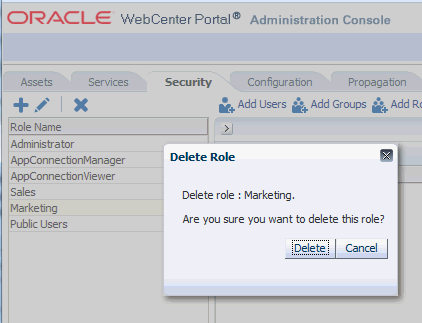
Description of "Figure 43-13 Deleting an Application Role"
-
When prompted, click Delete to confirm that you want to delete the role.
The role is removed from the table. Users assigned to only this role can still log in through the
authenticated-userrole.
43.5 Managing Assets for a Portal Framework Application
By using the Assets page of the administration console, you can manage your application assets—pages, page templates, navigations, resource catalogs, skins, page styles, content presenter display templates, task flow styles, data controls, and task flows (Figure 43-14). You can perform tasks such as create, edit, copy, publish, upload, and download your application assets. For information about various assets, see the "Introduction to Portal Resources" section in Oracle Fusion Middleware Developing Portals with Oracle WebCenter Portal and Oracle JDeveloper.
Figure 43-14 Administration Console - Assets Page
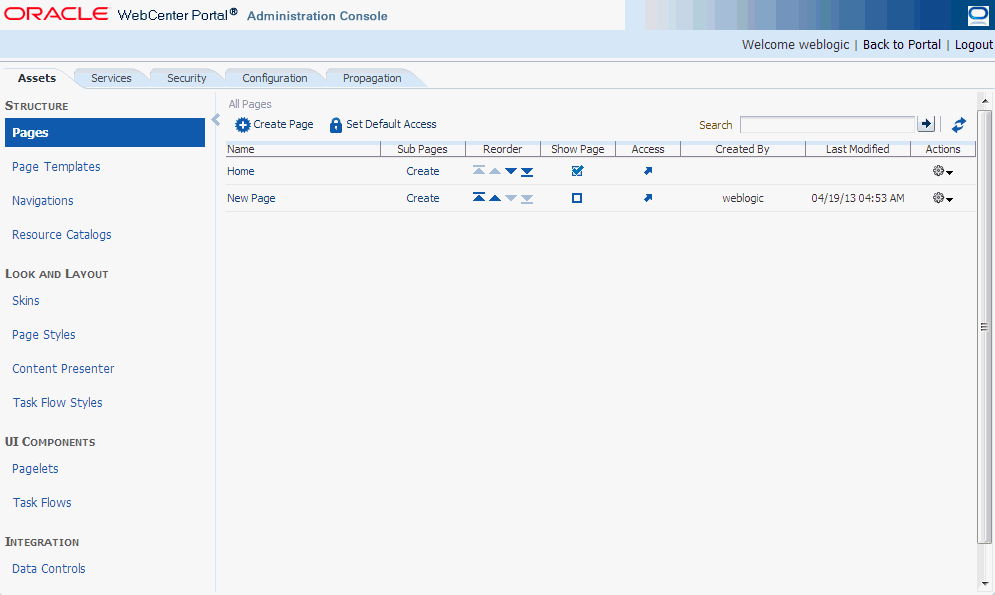
Description of "Figure 43-14 Administration Console - Assets Page"
This section includes the following topics:
43.5.1 Working with Pages
At runtime, you can create and manage application pages.
This section includes the following topics:
For information about editing, copying, or deleting a page, refer to the generic resource procedures documented later in this chapter.
43.5.1.1 Creating a Page
To create an application page at runtime:
-
Open the Assets tab in the administration console.
See Section 43.2, "Accessing the Administration Console for Portal Framework Applications."
-
In the navigation panel on the left, click Pages.
-
On the menu bar, click Create Page.
-
In the Create Page dialog (Figure 43-15), in the Page Name field, enter the name of the page.
-
From the Page Template list, select the page template on which you want to base your page.
-
From the Page Style list, select the style you want to use for your page.
For information about page styles, see the "Introduction to Page Styles" section in Oracle Fusion Middleware Developing Portals with Oracle WebCenter Portal and Oracle JDeveloper.
-
Click Create.
The newly created page is listed on the Assets page. You can mange the page by using the options available on the Actions menu of the page (Figure 43-16).
43.5.1.2 Creating a Subpage
The procedure to create a subpage is similar to creating a main page as described in Section 43.5.1.1, "Creating a Page." On the Assets page, you need to click Create in the Sub Pages column for the page under which you want to create the subpage (Figure 43-17). By default, subpages inherit security from their parent page.
Figure 43-17 Create Link for Creating a Subpage

Description of "Figure 43-17 Create Link for Creating a Subpage"
43.5.1.3 Setting Page Access
All your application pages reside under the root node, and by default, inherit the permissions defined for the root node. You can define custom permissions for the root node. Further, you can override the default root node permissions, and specify custom permissions for individual pages. By default, subpages inherit security from their parent page.
While setting page access, you can choose either of these access methods: Delegate Security or Inherit Parent Security (Figure 43-18).
Choose:
-
Delegate Security - to define who may interact with a page. When you select this option, all permissions that a page currently inherits from its parent are displayed in the dialog. This effectively is the current security policy applicable on the page. You can further refine the grants by adding new grants or removing the existing ones.
-
Inherit Parent Security - to inherit permissions defined for a page's parent node. When you set this option, any security permissions defined on the page are deleted, and the parent node's security settings take effect.
You can define the following page permission actions:
-
Manage - grants all other page permissions and is typically used for specifying a super administrator type of access. This permission action is available only when defining access on the root node.
-
Grant - allows a user to further grant the access that they already have to other users, groups, or roles. For example, if a user has the Grant and Edit permissions, the user can further grant these two actions only; she cannot grant any other permission, like Delete or Personalize.
-
Create - allows a user to create subpages under the current page.
-
Delete - allows a user to delete a page along with all its subpages.
-
Edit - allows a user to edit a page.
-
Personalize - allows a user to personalize a page.
-
View - allows a user to view a page.
All permissions follow one of the two permission models - delegation or containment. Delegation is when an entity has been granted a particular permission on a page, and this is all that is used to evaluate whether the entity has the said permission action or not. All permission actions other than View fall in this category. A permission is of containment type if the permission is granted to an entity on a page, as well as all the nodes up in the hierarchy where security is defined. Only the View permission action falls in this category.
So, to be able to view a page, you need to have the View permission action on the specified page and all nodes up in the hierarchy to the root node. If you do not have the View permission on an intermediate node in the page hierarchy, you cannot view the specified page. For other permission actions (delete, edit, and the like), you just need that particular permission on the page.
This section includes the following topics:
43.5.1.3.1 Setting Permissions on an Individual Page
To set permissions on a specific page:
-
Navigate to the Assets page, as described in Section 43.2, "Accessing the Administration Console for Portal Framework Applications."
-
In the left navigation panel, click Pages.
-
From the list of pages, open the Actions menu for the required page, then select Set Access.
-
In the Set Page Access dialog, select an access method (Figure 43-20):
-
Delegate Security—Select this method to define who may manage and update this page node, and all its children in the hierarchy that have not overridden security. Selecting this method shows the default permissions available. You can further refine the permissions by adding new permissions or removing the existing ones.
If you select this option, proceed to step 5.
-
Inherit Parent Security—Select this method to inherit permissions defined for the page's parent node. If you select this method, click OK to save your changes and exit the dialog.
-
-
If you selected Delegate Security, specify the user, group, or role to which you want to grant access to the page.
-
Click Add Users to search for and select individual users included in your identity store. Select the required user(s), and click OK.
-
Click Add Groups to search for and select groups of users included in your identity store. Select the required group(s), and click OK.
-
Click Add Roles to search for and select the application roles to which you want to grant access to the page. Select the required role(s), and click OK.
-
-
For each user, group, or role listed in the Role or User column, specify the level of access you want to grant. You can grant any of the following permissions: Grant, Create, Delete, Edit, Personalize, and View.
See Section 43.5.1.3, "Setting Page Access" for a description of each permission.
-
Optionally, you can click the Add Authenticated Role for Logged in User Access icon to add authenticated-role and define the access for all authenticated users. You can click the Add Anonymous Role for Public Access icon to add anonymous-role and grant the required permissions to all users.
-
If you want to revoke permissions from any user, group, or role, select that entity and click Delete Access.
-
Click OK to save the security settings for the page.
The lock icon in the Access column for a page signifies that Delegate Security access method has been set for the page; the arrow icon signifies that Inherit Parent Security access method has been set for the page (Figure 43-21).
Figure 43-21 Access Methods Specified for Pages

Description of "Figure 43-21 Access Methods Specified for Pages"
43.5.1.3.2 Setting Permissions on the Root Node
All page and subpage nodes that do not have security overridden, derive their access settings from the root node. You can define permissions for the root node by using the Set Default Access option on the Pages page on the Assets tab (Figure 43-22). The rest of the procedure is same as that for setting permissions for a specific page. For information, see Section 43.5.1.3.1, "Setting Permissions on an Individual Page."
When you set permissions for the root node, in addition to other permissions, you can also set the Manage permission. A user with this permission has complete access on the entire page hierarchy irrespective of the settings on individual pages.
Figure 43-22 Setting Access for the Root Node

Description of "Figure 43-22 Setting Access for the Root Node"
43.5.1.4 Reordering a Page
You can reorder your pages. This order is used when you include pages in the navigation model through a Page Query.
To change the order of a page:
-
Navigate to the Assets page in the administration console.
See Section 43.2, "Accessing the Administration Console for Portal Framework Applications."
-
In the left navigation panel, click Pages.
-
Drag the page to the required location in the page hierarchy.
To reorder pages, you can also use the icons displayed in the Reorder column (Figure 43-23). Use the icons to move your page to the top of the list, bottom of the list, before the preceding page, or after the page displayed next in the list.
43.5.1.5 Moving a Page in the Page Hierarchy
You can change the level at which a page appears in the page hierarchy—you can move a page to appear as a subpage, appear at the root level, or appear as a parent page.
To move a page in the page hierarchy:
-
Navigate to the Assets page in the administration console.
See Section 43.2, "Accessing the Administration Console for Portal Framework Applications."
-
In the left navigation panel, click Pages.
-
Open the Action menu for the page that you want to move, and choose Move Page (Figure 43-24).
-
In the Move Page dialog, select the level at which you want to move the page in the page hierarchy.
For example, if you want your page to appear as a subpage of MyPage, click MyPage (Figure 43-25).
-
Click OK.
In Figure 43-26, the subpage icon in the Sub Pages column represents that MyPage now contains a subpage.
Figure 43-26 A Page Updated in the Page Hierarchy

Description of "Figure 43-26 A Page Updated in the Page Hierarchy"
43.5.1.6 Renaming a Page
To rename a page:
-
Navigate to the Assets page in the administration console, as described in Section 43.2, "Accessing the Administration Console for Portal Framework Applications."
-
In the left navigation panel, click Page.
-
Open the Action menu for the page you want to rename, and choose Rename Page.
-
In the Rename Page dialog, enter the desired name.
-
Click OK.
43.5.2 Creating an Asset
Even after your application has been deployed, as an administrator, you may need to constantly update it to meet your organization's requirements. Portal Framework applications enable you to create and edit assets at runtime, without requiring you to redeploy your application.
Notes:
You cannot create Content Presenter display templates at runtime. For more information, see the "Creating Content Presenter Display Templates" chapter in Oracle Fusion Middleware Developing Portals with Oracle WebCenter Portal and Oracle JDeveloper.
To create an asset:
Notes:
The procedure for creating a page, pagelet, or data control is different than other assets:
-
For information about creating a page, see Section 43.5.1.1, "Creating a Page."
-
For information about creating a pagelet, see "Creating Pagelets with Oracle WebCenter Portal's Pagelet Producer" in Oracle Fusion Middleware Developing Portals with Oracle WebCenter Portal and Oracle JDeveloper.
-
For information about creating a data control see the "Creating Data Controls" section in Oracle Fusion Middleware Building Portals with Oracle WebCenter Portal. The procedure to create a data control at runtime in a Portal Framework application is similar to that in WebCenter Portal.
-
You can create page styles and task flow styles at runtime only by copying an existing style. For more information, see Section 43.5.3, "Copying an Asset."
-
Navigate to the Assets page in the administration console.
See Section 43.2, "Accessing the Administration Console for Portal Framework Applications."
-
In the left navigation panel, select the category of the asset you want to create.
-
On the menu bar, click Create.
-
In the Create dialog, in the Name field, enter the name of the asset.
-
In the Description field, enter a description of the asset.
-
From the Copy From list, select the existing asset that you want to extend for creating a new asset.
Note:
The Copy from list is available for page templates, navigations, resource catalogs, and skins. It is not available for task flows.
-
(For task flows only) Select the Task Flow Style that you want to use for the new asset.
-
Click Create.
The newly created asset is listed on the Assets page. The empty check box next to an asset indicates that it is not yet published and hence not available to users for use. For information about publishing assets, see Section 43.5.6, "Showing or Hiding an Asset."
43.5.3 Copying an Asset
You can create a copy of an asset. This feature is useful when you want to create a backup of an asset, update an asset while keeping the original in use, or use an existing asset as the starting point for creating a new asset. When you create a copy of an resource, the copy is marked as hidden.
To make a copy of an asset:
-
Navigate to the Assets page in the administration console.
See Section 43.2, "Accessing the Administration Console for Portal Framework Applications."
-
In the left navigation panel, select the desired type of asset.
-
From the list of assets, select the asset you want to copy.
-
From the Actions menu, choose Copy.
Note:
To make a copy of a page, select Copy Page from the Actions menu of the page. In the Copy Page dialog, specify the page name and click OK.
-
In the Copy dialog, in the Display Name field, enter a name for the copy (Figure 43-27).
-
In the Description field, enter a description of the new asset.
-
Click OK.
43.5.4 Editing Assets
At runtime, you can perform two types of asset editing:
-
Edit - provides a way to edit an asset either with Composer or in an Edit dialog.
-
Edit Source - enables you to work with the source code of an asset.
43.5.4.1 Editing an Asset Using the Edit Option
To edit an asset at runtime:
-
Navigate to the Assets page in the administration console.
See Section 43.2, "Accessing the Administration Console for Portal Framework Applications."
-
In the left navigation panel, select the desired type of asset.
-
From the list of assets, select the asset you want to edit.
-
In the Actions column, click Edit (Figure 43-28).
Note:
To edit a page, select the Edit Page option from the Actions menu of the page.
-
Edit the asset as desired.
The properties that you can edit vary from asset to asset. For information about the properties of an asset that can be edited, refer to the relevant asset chapter listed in the "Editing an Asset Using the Edit Option" section in Oracle Fusion Middleware Building Portals with Oracle WebCenter Portal. The procedure to edit an asset at runtime in a Portal Framework application is similar to that in WebCenter Portal.
43.5.4.2 Editing the Source Code of an Asset
To get more control over asset editing at runtime, you can edit the underlying source code of any custom asset, except data controls and pages.
To edit the source code of an asset:
-
Navigate to the Assets page in the administration console.
See Section 43.2, "Accessing the Administration Console for Portal Framework Applications."
-
In the left navigation panel, select the desired type of asset.
-
From the list of assets, select the asset you want to edit.
-
From the Actions menu, choose Edit Source.
The Edit Source dialog displays the asset definition.
-
Edit the code as required (Figure 43-29).
The XML syntax in the code is validated and an error message is displayed if you miss any tags or add them incorrectly. Validation is not performed for non-XML files, such as a CSS file.
Figure 43-29 Editing the Source of an Asset
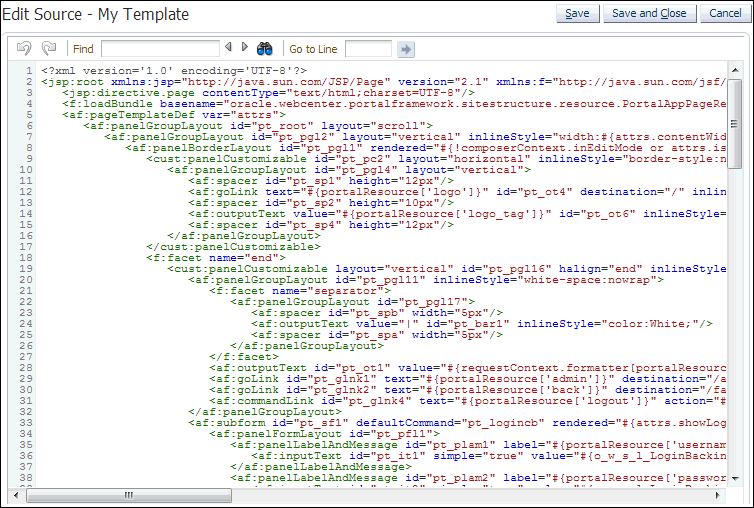
Description of "Figure 43-29 Editing the Source of an Asset"
-
When you are done, click Save and Close.
43.5.5 Setting Properties on an Asset
Each asset has certain associated properties that define its display properties and attributes. Authorized users can edit these properties by using the Edit Properties dialog. For information about the properties displayed in the Edit Properties dialog, see the "Viewing Information About an Asset" section in Oracle Fusion Middleware Building Portals with Oracle WebCenter Portal.
This section describes how to access the Edit Properties dialog and set asset properties. It includes the following topics:
Note:
The properties described in this section are not applicable to a page asset.
-
Section 43.5.5.1, "Accessing the Edit Properties Dialog of an Asset"
-
Section 43.5.5.2, "Editing the Name or Description of an Asset"
43.5.5.1 Accessing the Edit Properties Dialog of an Asset
To access the Edit Properties dialog of an asset:
-
Navigate to the Assets page in the administration console.
See Section 43.2, "Accessing the Administration Console for Portal Framework Applications."
-
In the left navigation panel, select the desired type of asset.
-
From the list of assets, select the asset you want to edit.
-
From the Actions menu, choose Edit Properties.
The Edit Properties dialog opens (Figure 43-30).
Figure 43-30 Edit Properties Dialog of an Asset
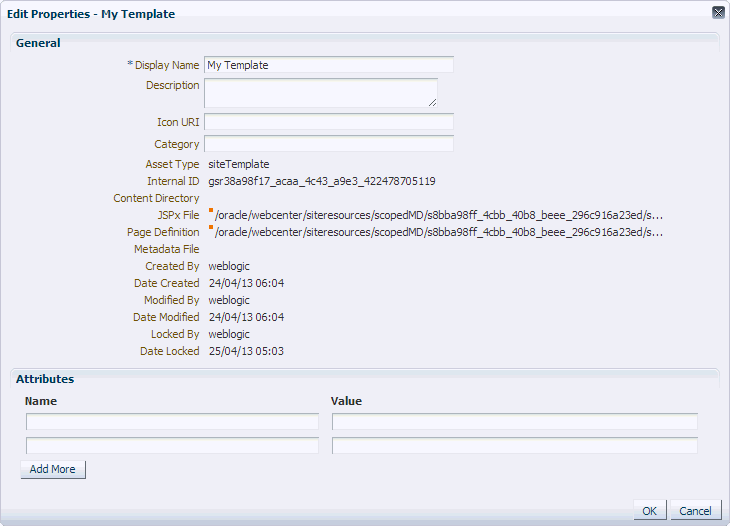
Description of "Figure 43-30 Edit Properties Dialog of an Asset"
-
Edit the properties as desired. For more information see:
-
When you are done, click OK.
43.5.5.2 Editing the Name or Description of an Asset
Assets are sorted on the Assets page according to their display names. To maintain a well-organized set of assets, consider developing a standard naming scheme and method of description. This is not a required step, but it may be useful in identifying and clarifying your intended purpose for a given asset.
To edit the name or description of an asset:
-
Open the Edit Properties dialog for the asset that you want to edit, as described in Section 43.5.5.1, "Accessing the Edit Properties Dialog of an Asset."
-
In the Display Name field, edit the display name of the asset.
-
In the Description field, enter a description of the asset.
-
Click OK.
43.5.5.3 Associating an Icon with an Asset
You can associate an icon with an asset. In the current version of WebCenter Portal, the associated icon is visible only for page styles when you create a page at runtime.
To associate an icon with an asset:
-
Open the Edit Properties dialog for the asset that you want to edit, as described in Section 43.5.5.1, "Accessing the Edit Properties Dialog of an Asset."
-
In the Icon URI field, enter a standard URI path to the desired icon.
For example, enter:
/mycompany/webcenter/page/images/myimage.png
You can specify either an absolute URL (where the URL should also work if entered in a browser address field), or a relative URL that points to an image located in the
/oracle/webcenter/siteresources/scopedMD/sharedfolder of your application. -
Click OK.
43.5.5.4 Categorizing an Asset
You can classify assets into relevant groups. For example, all page styles associated with Sales could be have a sales category. This value is available and exposed only in the Edit Properties dialog.
To categorize an asset:
-
Open the Edit Properties dialog for the asset that you want to edit, as described in Section 43.5.5.1, "Accessing the Edit Properties Dialog of an Asset."
-
In the Category field, enter a category name.
-
Click OK.
43.5.5.5 Setting Asset Attributes
In addition to the default attributes exposed through the Edit Properties dialog (Display Name, Description, and so on), you can expose custom attributes for assets. The Edit Properties dialog provides an Attributes section for entering attribute name/value pairs (Figure 43-31).
Figure 43-31 Attributes Section of an Asset

Description of "Figure 43-31 Attributes Section of an Asset"
For example, editPageAfterCreation is a custom attribute of page styles and controls whether a newly created page of a particular style opens in Edit or View mode. It takes a value of true or false. When you associate this attribute with a particular page style, every time a user creates a page based on the selected style, the attribute value is considered and the page functions accordingly.
To set an asset attribute:
-
Open the Edit Properties dialog for the asset that you want to edit, as described in Section 43.5.5.1, "Accessing the Edit Properties Dialog of an Asset."
-
In the Attributes section, in the Name field, enter the attribute name.
-
In the Value field, enter a value for the attribute.
-
Click Add More if you want to add more attributes.
This adds a new row to the Attributes section. You can then enter the required details in the Name and Value fields.
-
To remove an attribute that is associated with an asset, click the Remove icon displayed next to the attribute that you want to remove.
-
Click OK.
43.5.6 Showing or Hiding an Asset
When you create an asset, by default the asset is marked as hidden. A hidden asset is not available for use in the asset picker. For an asset to become available, it must be published.
For all assets that are available to use, a check box marked with a blue tick appears in the Available column for the asset on the Assets page. An empty check box in the Available column indicates that the asset is marked as hidden, as shown in Figure 43-32.
To show or hide an asset:
-
Navigate to the Assets page in the administration console.
See Section 43.2, "Accessing the Administration Console for Portal Framework Applications."
-
In the left navigation panel, select the desired type of asset.
-
From the list of assets, select the asset that you want to show or hide.
-
To show a hidden asset, select the empty check box in the Available column.
To hide an available asset, deselect the check box in the Available column.
Note:
To mark a page as available, select the check box in the Show Page column in the Assets page. If this check box is empty, the page is marked as hidden.
43.5.7 Setting Asset Security
You can control whether all users or only specific users or groups can access the assets in your application. By default, asset access is controlled by application-level permissions. The Security Settings dialog provides a means of setting aside application-level permissions and defining specific permissions on a selected asset.
For information about setting page access, see Section 43.5.1.3, "Setting Page Access."
To set access permissions on any asset other than a page:
-
Navigate to the Assets page in the administration console
See Section 43.2, "Accessing the Administration Console for Portal Framework Applications."
-
In the left navigation panel, select the desired type of asset.
-
From the list of assets, select the asset on which you want to set access permissions.
-
From the Actions menu, select Security Settings.
-
In the Security Settings dialog, specify an access method by selecting either of the following options (Figure 43-33):
-
Use Custom Permissions—Select this option to define who may manage and update the selected asset. If you select this option, the other controls in the dialog become available. Proceed to step 6.
Note:
When you choose Use Custom Permissions, ensure that at least one user or group is granted the Manage access.
-
Use Application Permissions—Select this option to inherit the selected asset's access settings from those defined for the application. If you select this option, click OK to save your changes and exit the dialog.
Note:
Selecting Use Application Permissions removes all custom permissions that you may have set.
Figure 43-33 Security Settings Dialog for an Asset
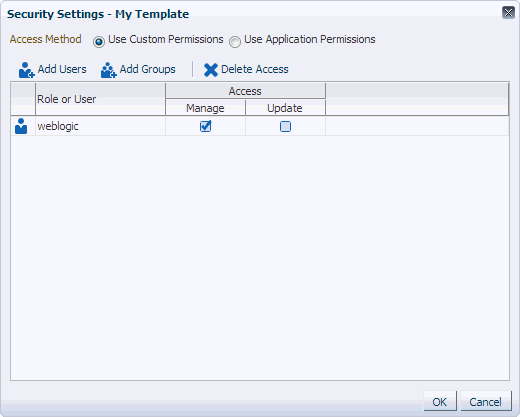
Description of "Figure 43-33 Security Settings Dialog for an Asset"
-
-
If you selected Use Custom Permissions, specify the user or group to whom you want to grant asset access.
-
Click Add Users to search for and select individual users available in your identity store.
-
Click Add Groups to search for and select groups of users available in your identity store.
-
-
For each user or group selected, specify the level of access you want to grant. Select:
-
Manage to grant full access to the asset. Such users can perform such tasks as edit, delete, grant access, show or hide, and so on.
-
Update to grant the permission to edit the asset. Such users can edit the asset, but they cannot delete it.
-
-
If you want to revoke permissions from any user or group, select that entity and click Delete Access.
-
Click OK.
43.5.8 Uploading and Downloading an Asset
In your deployed application, you can edit assets at runtime. However, for greater control, you may want to edit an asset at design time. For this, you can download the asset created at runtime, edit it at design time in JDeveloper, and then upload the updated asset back into the application without redeploying the application.
Note:
Pages and pagelets cannot be downloaded or uploaded at the asset level.
The Download and Upload options enable post-deployment, round-trip application development. These actions greatly simplify the process of bringing new or revised assets from JDeveloper into your application and pushing them back into development from your application to JDeveloper as needed.
43.5.8.1 Downloading an Asset
When you download an asset, its configuration is saved into an archive file. You can save the archive file either to your local file system or a remote server file system.
To download an asset:
-
Navigate to the Assets page in the administration console
See Section 43.2, "Accessing the Administration Console for Portal Framework Applications."
-
In the left navigation panel, select the desired asset type.
-
From the list of assets, select the asset you want to download.
-
In the menu bar, click Download.
-
In the Download dialog, in the Archive File Name field, enter the name of the export archive file.
-
Select:
-
Save to My Computer - to save the export archive file to your local file system.
-
Save to WebCenter Portal Server - Click this to save the export archive file to a remote server file system. In the Path field, enter the location on the server where you want to save the archive file.
-
-
Click Download.
-
After downloading the asset, you can then import it into JDeveloper.
43.5.8.2 Uploading an Asset
After editing your assets in JDeveloper, you can upload them into your application at runtime.
When you upload an asset:
-
Existing assets, that is, assets with the same internal ID, are overwritten.
-
Assets must be in an archive file format on your local file system or a remote server.
To upload an asset at runtime:
-
Navigate to the Assets page in the administration console
See Section 43.2, "Accessing the Administration Console for Portal Framework Applications."
-
In the left navigation panel, select the desired asset type.
-
In the menu bar, click Upload.
-
In the Upload dialog, select:
-
Look on My Computer to upload an archive file from your local file system. Click Choose File to locate the file.
-
Look on WebCenter Portal Server to upload an archive file from a remote server file system. In the field below, enter the location on the server where the file is located.
-
-
Click Upload.
-
If the asset already exists in the portal, click Yes to confirm that you want to replace the asset with the contents of the archive file.
43.5.9 Previewing an Asset
You can edit assets at runtime, preview the changes, and make further adjustments as needed.
To preview an asset:
-
Navigate to the Assets page in the administration console
See Section 43.2, "Accessing the Administration Console for Portal Framework Applications."
-
In the left navigation panel, select the desired asset type.
-
Click the name of the asset that you want to preview.
Note:
Not all assets can be previewed. If the name of the asset is not a hyperlink, then it cannot be previewed.
The asset is displayed as it would appear when used in a portal.
-
View and interact with the asset to determine whether it looks and behaves the way you want.
-
When you are done, click Close.
You can either edit the asset to make changes or publish it to make it available in the application.
43.5.10 Deleting an Asset
When an asset is no longer required, you may want to remove it from your application. You cannot delete built-in assets.
Note:
Before you delete an asset, you must ensure that the asset is not in use. If you mark an asset for deletion, it is deleted even if it is use.
To delete an asset:
-
Navigate to the Assets page in the administration console.
See Section 43.2, "Accessing the Administration Console for Portal Framework Applications."
-
In the left navigation panel, select the desired asset type.
-
From the list of assets, select the asset you want to delete.
-
On the menu bar, click Delete.
Note:
To delete a page, select the Delete Page option from the Actions menu of the page. When you delete a page, its subpages are also deleted.
-
In the Delete dialog, click OK to complete the process.
43.6 Configuring Services, Portlet Producers, and External Applications for Portal Framework Applications
You can manage and configure several WebCenter Portal services for a Portal Framework application through the WebCenter Portal Administration Console. From the Services tab (Figure 43-34), you can manage and configure the content repository, polls, portlet producers, and external applications.
Figure 43-34 WebCenter Portal Administration Console - Services Tab

Description of "Figure 43-34 WebCenter Portal Administration Console - Services Tab"
Some services, such as Analytics, are ready to use out-of-the-box and do not require administrator-level configuration. Other services, such as Polls, require additional configuration by users with administrative privileges to get things up and running.
This section includes the following topics:
43.6.1 Managing Content
System administrators can manage content that is stored in the application's primary content repository through the WebCenter Portal Administration Console (Figure 43-35). Administrators can add, edit and update content from here, manage document version history, and also access useful information such as direct URLs and download URLs for files and folders.
The systems administrator is responsible for registering content repositories for Portal Framework applications and determining the primary (or default) content repository. If you expected this administration page to display content from a different content repository, the primary (or default) content repository connection may need to be reconfigured. See Section 9.7, "Changing the Active (or Default) Content Repository Connection."
Figure 43-35 Contents of a Primary Documents Repository
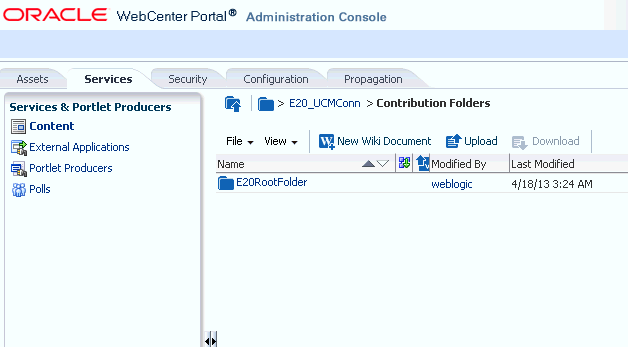
Description of "Figure 43-35 Contents of a Primary Documents Repository"
This section includes the following topics:
-
Section 43.6.1.7, "Viewing Version History of a Content Item"
-
Section 43.6.1.8, "Getting Direct and Download URLs of a Document"
-
Section 43.6.1.9, "Organizing Columns for the Displayed Content"
-
Section 43.6.1.10, "Setting Up Security on Folders and Documents"
43.6.1.1 Creating a New Folder
To create a new folder:
-
Navigate to the Administration console and open the Services tab.
See Section 43.2, "Accessing the Administration Console for Portal Framework Applications."
-
Select Content.
-
Open a folder in which you want to create a new folder.
-
From the File menu, select New Folder...
-
In the Create Folder dialog, enter a descriptive name in the Folder Name field, and then click Create to create the folder.
Tip:
To rename or delete a folder, select the appropriate option from the File menu. This menu also provides options to cut, copy, and paste contents in a folder.
To hide folders in a directory, from the View menu, select Hide Folders. To make hidden folders visible, deselect the Hide Folders option.
43.6.1.2 Creating a Wiki Page
To create a wiki document:
-
Navigate to the Administration console and open the Services tab.
See Section 43.2, "Accessing the Administration Console for Portal Framework Applications."
-
Select Content.
-
Select a folder in which you want to create your wiki page.
-
Click New Wiki Document.
The Rich Text Editor displays.
-
In the Title field, enter a descriptive title, and click Create to create the wiki page in the chosen folder.
43.6.1.3 Editing a File
To edit contents such as a wiki document:
-
Navigate to the Administration console and open the Services tab.
See Section 43.2, "Accessing the Administration Console for Portal Framework Applications."
-
Select Content.
-
Click the item you want to edit.
You can edit wikis, blogs, and other Rich Text-based content directly. For other file formats you must download, make your changes, and then upload the file.
-
From the File menu, select Edit.
For Wikis, the file opens in the Rich Text Editor, as shown in Figure 43-36.
Figure 43-36 A Wiki Page Opened for Editing
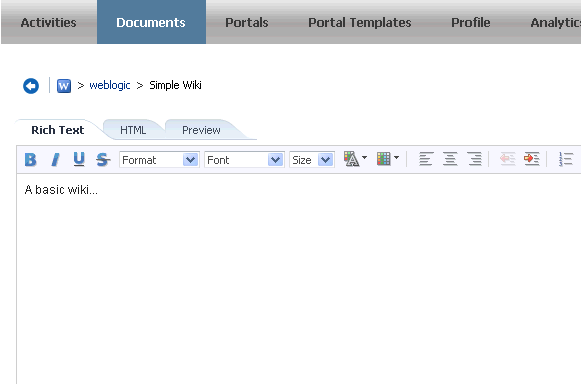
Description of "Figure 43-36 A Wiki Page Opened for Editing"
-
Click Save and Close to close the document after saving.
43.6.1.4 Uploading a Document
To upload a document:
-
Navigate to the Administration console and open the Services tab.
See Section 43.2, "Accessing the Administration Console for Portal Framework Applications."
-
Select Content.
-
Select a folder into which you want to upload your document.
-
Click Upload Document. The Upload Document to <Folder Name> dialog displays.
-
In the Upload Document section, click Browse and select the required document. In the Description section you can enter a description if you like, and then click Upload. Your document is uploaded in the chosen directory.
The maximum file upload size in Portal Framework applications is 2 MB. Portal Framework application developers can customize this limit at design time.
Tip:
You can upload multiple documents at a time. You can add more field to upload as many documents as you like by clicking More.
To download a document, select it and click Download.
43.6.1.5 Checking Out a Document
To check out a document:
-
Navigate to the Administration console and open the Services tab.
See Section 43.2, "Accessing the Administration Console for Portal Framework Applications."
-
Select Content.
-
Select the document you want to check out.
-
From the File menu, select Check Out. The document is checked out and the lock icon appears to indicate its checked out status, as shown in Figure 43-37.
Tip:
To cancel check out, select the document in the directory it is located, and from the File menu choose Cancel Check Out.
43.6.1.6 Uploading a New Version of a Document
To upload a new version of a document:
-
Navigate to the Administration console and open the Services tab.
See Section 43.2, "Accessing the Administration Console for Portal Framework Applications."
-
Select Content.
-
Select the document you want to check out.
-
From the File menu, select Upload New Version.
-
In the Upload New Version dialog, click Browse to select another version of the document, as shown in Figure 43-38. You can enter a description, if you like, and then click Upload.
Figure 43-38 Upload a New Version of a Document

Description of "Figure 43-38 Upload a New Version of a Document"
43.6.1.7 Viewing Version History of a Content Item
To view the version history of a document such an image or a wiki page:
-
Navigate to the Administration console and open the Services tab.
See Section 43.2, "Accessing the Administration Console for Portal Framework Applications."
-
Select Content.
-
Navigate to the folder in which your documents are located.
-
Select a document to view its version history.
-
From the View menu, select Version History. The version history displays, as shown in Figure 43-39.
Figure 43-39 Version History of a Document
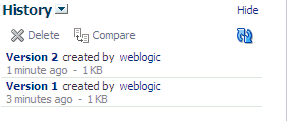
Description of "Figure 43-39 Version History of a Document"
Tip:
To view properties of an item, select this item in the directory it is located, and from the View menu, select Properties.
43.6.1.8 Getting Direct and Download URLs of a Document
A direct URL lets you view a document, whereas a download URL lets you download it. To get these URLs:
-
Navigate to the Administration console and open the Services tab.
See Section 43.2, "Accessing the Administration Console for Portal Framework Applications."
-
Select Content.
-
Navigate to the folder in which your documents are located.
-
Select a document to get its URLs.
-
From the View menu, select Get a Link.
-
In the Get a Link dialog, click the Direct URL if you want to view this document. To download this document, click Download URL.
43.6.1.9 Organizing Columns for the Displayed Content
For each item in a primary repository you can choose what associated information you would like to display, such as name of a content item, its last modified date, its check out status, and so on. You can also reorder chosen columns to display the desired information in a specific order.
43.6.1.9.1 Showing Columns
To choose columns that will display the desired information associated with your content items:
-
Navigate to the Administration console and open the Services tab.
See Section 43.2, "Accessing the Administration Console for Portal Framework Applications."
-
Select Content.
-
Navigate to the folder in which your documents are located.
-
From the View menu, select Columns and then choose titles that will display the desired information for your content items, as shown in Figure 43-8.
43.6.1.9.2 Reordering Columns
To reorder columns:
-
Navigate to the Administration console and open the Services tab.
See Section 43.2, "Accessing the Administration Console for Portal Framework Applications."
-
Select Content.
-
Navigate to the folder in which your documents are located.
-
From the View menu, select Reorder Columns.
The Reorder Columns dialog displays, as shown in Figure 43-42.
43.6.1.10 Setting Up Security on Folders and Documents
Under the Contents tab, in the File menu, the Security menu item for a document or folder is visible when the following conditions are met:
-
Item level security has been enabled in Oracle WebCenter Content Server, as described in Section 9.2.3.10, "Configuring Item Level Security."
-
If the security group assigned to these documents is listed in the
SpecialAuthGroupssetting at the time when the item level security is enabled in Oracle WebCenter Content Server, as described in Section 9.2.3.10, "Configuring Item Level Security." -
The user has administrative rights on the document or folder in Oracle WebCenter Content Server.
For information about using the security feature, see the "Setting Security Options on a Folder or File" section in Oracle Fusion Middleware Using Oracle WebCenter Portal.
43.6.2 Managing Portlet Producers
You can use the administration console to register, edit, and delete portlet producers. For more information about using the administration console to manage portlet producers, see Section 21.9, "Managing Portlet Producers with the Administration Console."
43.6.3 Managing External Applications
You can use the WebCenter Portal Administration Console to register, edit, and delete external applications. For more information about using the WebCenter Portal Administration Console to manage external applications, see Section 23.4, "Managing External Applications with the WebCenter Portal Administration Console."
43.6.4 Creating and Configuring Polls
System administrators can create and configure online polls for a Portal Framework application at runtime through the WebCenter Portal Administration Console. With polls, you can survey your audience (such as their opinions and their experience level), check whether they can recall important information, and gather feedback.
This section includes the following topics:
43.6.4.1 About Polls
With polls, in addition to taking available polls, you can do the following:
-
Create a poll by clicking the Create Poll icon, and then adding section headings and questions to it
-
Schedule the poll for distribution
-
Save the poll as a template for use with new polls
-
Analyze the results of the poll
Polls is integrated with many WebCenter Portal services, such as RSS, Search (to search poll text), Instant Messaging and Presence, and Recent Activities.
Figure 43-43 shows an example poll.
Polls must be published and open before they can be completed by users. Users cannot complete unpublished or closed polls.
43.6.4.2 Creating, Configuring, and Analyzing a Poll
From the Polls page (Figure 43-44) you can create polls, perform operations on them, including edit polls, save (as a poll or as a poll template), publish polls, close polls, analyze the status of current polls, and delete polls. You can update poll data on the Polls page at any time by clicking the Refresh icon.
To add a new poll:
-
Click the Services administration tab.
See Section 43.2, "Accessing the Administration Console for Portal Framework Applications."
-
Click Polls (Figure 43-44).
Figure 43-44 WebCenter Portal Administration Console - Polls

Description of "Figure 43-44 WebCenter Portal Administration Console - Polls"
-
Click Create Poll.
The Create Poll dialog displays (Figure 43-45).
-
Enter a Name and, optionally, a Description for the poll, then click Create.
The Design tab displays (Figure 43-46).
-
Click Add and select an option (Figure 43-47).
Select from the following options:
-
Add Question—to add a new poll question
-
Add Section—to add a section to the poll
-
Add Template—to apply an existing template to the poll
-
-
To add a section to organize your poll questions, click Add Section.
The Create Section dialog displays (Figure 43-48).
Figure 43-48 Polls - Create Section Dialog
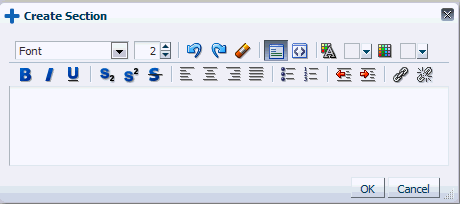
Description of "Figure 43-48 Polls - Create Section Dialog"
-
Enter any explanatory text or descriptive text for the section in the rich text editor (Figure 43-48).
-
Apply formatting to the section heading, if you choose to do so.
-
Click OK.
-
Click Add and then select Add Section to add other sections to your poll.
-
-
Click Add in a section to add a poll question under the section and then select Add Question (Figure 43-49) to add each poll question.
The Create Question dialog displays (Figure 43-50).
-
Select the Question Type from the drop-down list (Figure 43-51):
Figure 43-51 Polls - Create/Edit Question Dialog - Question Type

Description of "Figure 43-51 Polls - Create/Edit Question Dialog - Question Type"
-
Enter the Question text and the Answer Choices (Figure 43-52).
For multiple choice questions, each choice must be on a separate line.
Figure 43-52 Polls - Create Question Dialog

Description of "Figure 43-52 Polls - Create Question Dialog"
-
Select Add Comment Field if you want users to add an explanation or comment to their response, then enter a label for the field and specify the number of rows.
-
Select Require Answer to Question if you want the question to be mandatory.
-
Click OK.
For this example, the current design is shown in Figure 43-53.
Figure 43-53 Create Polls Example - Design Tab

Description of "Figure 43-53 Create Polls Example - Design Tab"
-
Click Add and then select Add Question to add other questions to the section.
-
-
Click the Schedule tab to specify publish and close options for the poll (see Figure 43-54).
Polls must be published and open for users to take. Users cannot take unpublished or closed polls.
-
Make a selection from Publish Options.
Select to keep the poll in draft mode for further editing, publish it immediately, or publish it on a future date.
If you select to publish it on a future date, click the Select Date and Time icon to enter the publishing time through a calendar.
Click Edit Introduction Message to customize the text provided at the beginning of the poll in the rich text editor.
-
Make a selection from Close Options.
Select to close the published poll after it reaches a certain number of responses or on a certain date. If you select both options, then the poll closes when either condition is first met.
If you select to close the poll on a specific date, click the Select Date and Time icon to enter the closing time through a calendar.
Click Edit Closing Message to customize the text provided at the end of the poll in the rich text editor.
-
Click OK.
-
Click Save to save your schedule.
-
-
Click Settings to select what to display after users take the poll (Figure 43-55).
For example, you can set a custom URL or JSF task flow as a Thank You page that appears after the poll is taken.
-
After conducting the poll, open the Analyze tab to view the poll data. (Figure 43-56).
-
Click Save to save your poll (Figure 43-57).
When you save any poll, you can select to save it as a template. After it is saved as a template, you can later apply that poll template to other polls.
Figure 43-58 shows your poll after it is published on a portal page. For users to view and take polls, add the Take Polls task flow to a page. See Section 43.6.4.7, "Taking Polls."
Figure 43-58 Poll Shown in the Take Polls Task Flow
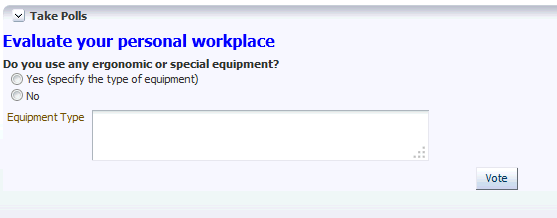
Description of "Figure 43-58 Poll Shown in the Take Polls Task Flow"
43.6.4.3 Editing a Poll
To edit a poll:
-
Click the Services administration tab.
See Section 43.2, "Accessing the Administration Console for Portal Framework Applications."
-
Click Polls (Figure 43-44).
-
Click the poll name link to edit the poll name and description.
-
Click the Actions menu and then select Design to make any changes (Figure 43-59).
See Section 43.6.4.2, "Creating, Configuring, and Analyzing a Poll" for more information.
-
Click Save and then Close.
43.6.4.4 Deleting a Poll
To delete a poll:
-
Click the Services administration tab.
See Section 43.2, "Accessing the Administration Console for Portal Framework Applications."
-
Click Polls (Figure 43-44).
-
Select the poll, click the Actions menu and select Delete (Figure 43-60).
-
Click Yes in the Delete Poll dialog.
-
Click Save and then Close.
43.6.4.5 Closing a Poll
To close a poll:
-
Click the Services administration tab.
See Section 43.2, "Accessing the Administration Console for Portal Framework Applications."
-
Click Polls (Figure 43-44).
-
Select the poll, click the Actions menu and select Close (Figure 43-61).
The Close option is available only after a poll is published.
The Status of the poll changes to Closed, showing the date and time the poll closed.
Tip:
Click the Actions menu and select Publish if you want to open the poll again.
-
Click Save and then Close.
43.6.4.6 Analyzing the Results of a Poll
You can analyze the results for a poll after users have taken the poll.
To analyze a poll:
-
Click the Services administration tab.
See Section 43.2, "Accessing the Administration Console for Portal Framework Applications."
-
Click Polls (Figure 43-44).
-
Click the Actions menu and select Analyze (Figure 43-62).
The Analyze page appears (Figure 43-63).
Figure 43-63 Polls Manager - Analyze Page

Description of "Figure 43-63 Polls Manager - Analyze Page"
-
If the poll included a field for poll takers to add comments, click View Summary to see consolidated comments.
The Response Summary dialog appears (Figure 43-64).
Expand the name of the poll's custom field name to view all comments, if you gave poll respondents an option to add comments.
43.6.4.7 Taking Polls
The Take Polls task flow (Figure 43-43) displays the most recently-published available poll, unless it is set to display a specific poll with the Poll Id parameter (Figure 43-65).
Note:
To work with the Take Polls task flow:
-
If the Take Polls task flow is not in your resource catalog, it must be added to the resource catalog and that resource catalog must be applied to the Resource Catalog for Pages. See the "Developing Resource Catalogs" chapter in Oracle Fusion Middleware Developing Portals with Oracle WebCenter Portal and Oracle JDeveloper.
-
The Take Polls task flow must be added to the appropriate page in your portal. See the "Creating Pages and Adding Resources" chapter in Oracle Fusion Middleware Developing Portals with Oracle WebCenter Portal and Oracle JDeveloper
After a user submits a response for that poll, this task flow displays the next most recently-published poll.
43.6.4.8 Setting Polls Task Flow Properties
The Polls task flows have associated properties, which users with sufficient privileges can access through the Component Properties dialog in Composer (Figure 43-65).
Figure 43-65 Task Flow Component Properties
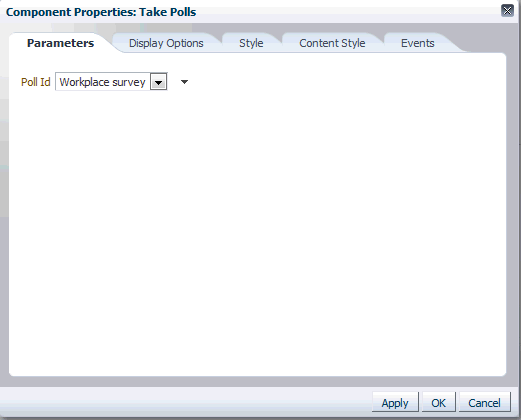
Description of "Figure 43-65 Task Flow Component Properties"
Note:
See the "Polls Task Flow Parameters" table in Oracle Fusion Middleware Developing Portals with Oracle WebCenter Portal and Oracle JDeveloper for information.
43.7 Propagating Portal Framework Application Changes From Staging to Production
The WebCenter Portal Administration Console includes a propagation tool for moving Portal Framework application metadata from a staging to a production server. Site administrators use this tool occasionally to push approved changes to the production server without incurring any downtime. For more details, see the "Using the Propagation Tool to Propagate From Staging to Production" section in Oracle Fusion Middleware Developing Portals with Oracle WebCenter Portal and Oracle JDeveloper.
